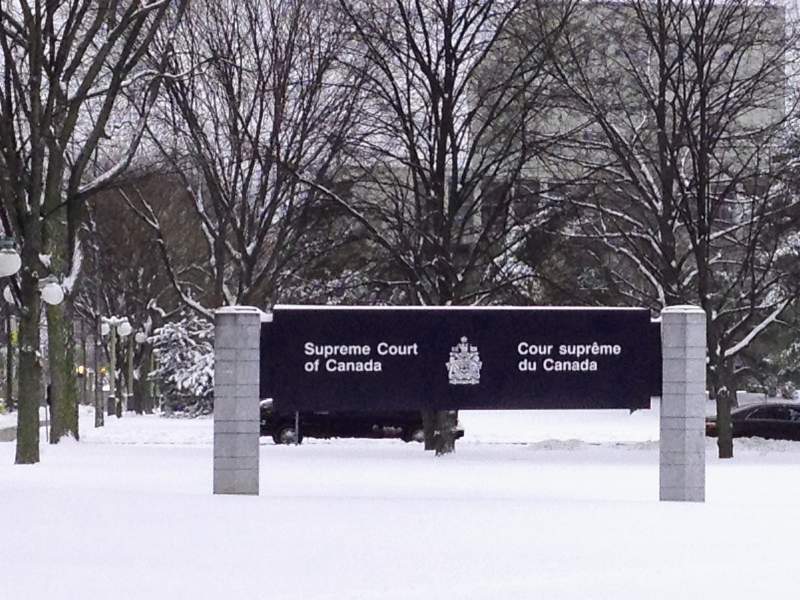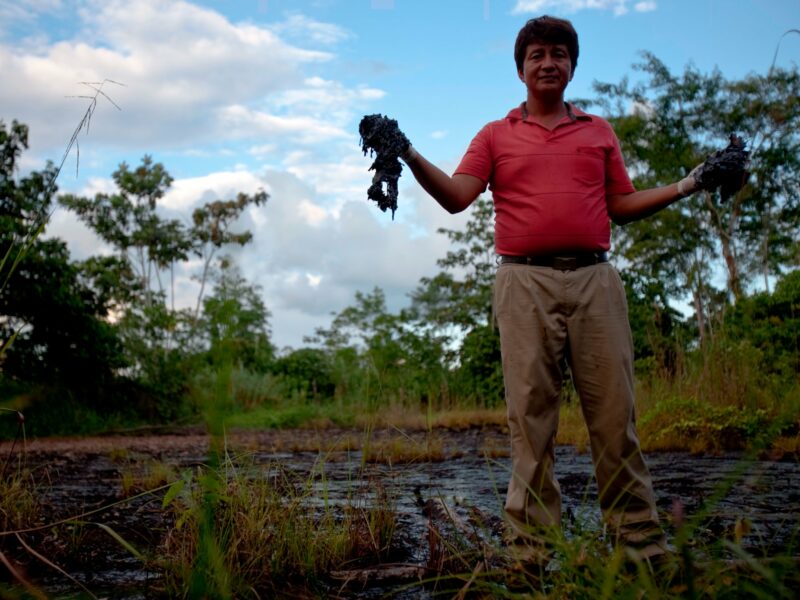
Ottawa, CA – Hockey. Maple syrup. Round bacon. Canada is known for many things. But it is also now, unexpectedly, the new battleground for one of the world’s most epic environmental litigations.
With sub-freezing temperatures and the first snow of the season on the ground, one might have thought that hell had indeed frozen over and that Chevron was finally ready to fight it out on the ice, as promised, in its effort to avoid paying a $9.5 billion judgment to Ecuadorian rainforest communities. But the hearing this month before Canada’s Supreme Court was just Chevron’s latest legal maneuver to deny justice to 30,000 Ecuadorian indigenous and farmer communities seeking clean water, healthcare, and a full remediation of the contamination the company left behind over two decades ago.
Having been found guilty in trial by a court of its own choosing in Ecuador, Chevron removed assets from the country and fled long ago. On the lam, Chevron has forced the communities to chase company assets around the world – a global game of cat and mouse where Chevron, with unlimited time and resources, hopes to outlast communities who are desperate for relief after 22 years of litigation.
Chevron’s Silvia Garrigo, who you might remember from such memorable quotes as, “I have makeup on, and there’s naturally occurring oil on my face. Doesn’t mean that I’m going to get sick from it,” also tellingly declared to 60 Minutes that, “We don’t want to be in any court. Period.” Indeed. In every forum and at every chance, Chevron has invented new ways to deny and delay – turning the truth, common sense, and the law – on its head.
The Ecuadorians actually brought the ruling to Canada in 2012, where the judiciary has a long history of upholding and enforcing foreign judgments, and Chevron has some $15 billion in assets via its wholly owned subsidiary, Chevron Canada. A lower Canadian court had allowed the Ecuadorian enforcement action to proceed, finding, “After all these years, the Ecuadorian plaintiffs deserve to have the recognition and enforcement of the Ecuadorian judgment heard in an appropriate jurisdiction,” according to a decision issued by a three-judge panel of the Court of Appeal of Ontario. “At this juncture, Ontario is that jurisdiction.”
This month’s hearing before the Supreme Court was Chevron’s last appeal to try to stop a full enforcement trial from happening. Chevron audaciously asked the Supreme Court to ignore all precedent, and to change the law just for them. Chevron called on the seven justices to treat the Ecuadorian enforcement action as if it were a brand new case, filed for the first time, and thereby subject to arguments on whether Canada was the proper jurisdiction and forcing Ecuadorians to show a connection to the country.
But the law is crystal clear. This is not a new trial. The trial happened – in Ecuador – and there was a judgment. This is an enforcement action to make Chevron pay that judgment. This is the sheriff showing up to the deadbeat dad’s house, dragging his ass to jail, and confiscating his stuff to pay for all the past money he owes. Seeing through Chevron’s absurd request, the justices interrupted company counsel repeatedly. “You’re asking us to make new law?” asked the court in disbelief.
Canada’s highest court was rightfully skeptical, because any new law, or “test” as it is know for jurisdiction hurdles, would affect precedent for similar cases. Pressed as to why the company was entitled to its own rules, and what their implications would be on other cases, Chevron had no answer.
“What I’m asking is how would this new test apply to other cases, and what I’m hearing is you don’t know,” said Justice Thomas Cromwell.
As if Chevron’s attempt at a special law protecting it wasn’t enough, Chevron proceeded to claim that the oil giant had no assets in Canada – that Chevron Canada is a separate entity from the parent company in San Ramon, CA, and that the judgment the Ecuadorians are trying to enforce is against Chevron Corporation. (A reverse corporate veil argument for the legal geeks.)
However, Chevron Canada is 100% owned by Chevron Corporation, has no independent board of directors, and its corporate officers are the employees of Chevron Group. Chevron Corporation has no revenue generating activity or direct earnings at all. All of its revenue comes from its subsidiaries via remittances, with the parent providing financing. Chevron does not even own its San Ramon, CA world headquarters. For all intents and purposes, it’s a shell company structured to benefit from all of its subsidiaries, and shield itself from liabilities. Welcome to the world of the corporate veil – how companies get all of the benefits from incorporation, and none of the downsides.
Ultimately, Chevron will have a chance to explain why it believes Chevron Canada’s assets, including major operations in the tar sands region of Alberta, aren’t subject to seizure by the Ecuadorians to satisfy the judgment if the Supreme Court denies Chevron’s appeal and an enforcement trial begins.
But where does Chevron’s catch-me-if-you-can act end?
A Troubled History in the North & South
The case was first filed in 1993 in New York Courts – because that is where Texaco executives made the decisions to use cheap, substandard and obsolete technology that lead to the systematic pollution. Its drill and dump practices left behind some 1000 superfund style oil drilling waste pits, spilled some 18 million gallons of crude, and dumped 4.3 billion gallons of toxic waste water into the rainforest. Before the court, Texaco argued that it wasn’t the Texaco Inc. parent company that was responsible, it was Texpet, an Ecuadorian subsidiary who was the operator of oil field activity.
Then, while arguing in New York that Ecuador was the proper forum and the Andean country’s judicial system was independent and transparent, Texaco was bought by Chevron, and a new company, ChevronTexaco, was formed. After several months, Chevron conveniently dropped ‘Texaco’ from the name, and then argued to the court that Chevron was now not subject to the litigation because Texaco did not exist anymore. Fortunately, the 2nd Circuit Court of Appeals in New York did not buy Chevron’s absurd argument, scolding, “There is no indication in the record before us that shortening its name had any effect on ChevronTexaco’s legal obligations. Chevron Corporation therefore remains accountable for the promises upon which we and the district court relied in dismissing Plaintiffs’ action.” The court, at Chevron’s request, dismissed the case to Ecuador, where it promised to accept jurisdiction and to be bound by any decision handed down from Ecuadorian courts.
However, a funny thing happened on the way to Ecuador. Chevron, in opening arguments of what would be a ten year trial, declared yet again that Ecuador was not the proper forum, and Chevron was not the proper company on the hook for one of the world’s worst oil disasters. Ultimately, Chevron was found guilty in a decision that was upheld by three different layers of Ecuadorian courts, including the country’s Supreme Court. So Chevron upped and left, promising the indigenous communities and farmers a “lifetime of litigation” and forcing them to take their quest for a clean up, clean water, and healthcare to foreign courts.
Back in Canada, Chevron counsel argued to the Supreme Court justices that Canada was not the proper forum, and the Ecuadorian communities could go elsewhere to enforce, like the United States. However, Chevron has bared the Ecuadorians from enforcing their judgment in New York with its retaliatory RICO suit against the villagers and their lawyers, pending an appeal before the 2nd Circuit in the coming months.
But why is it the Ecuadorians’ burden to chase Chevron to pay? They have a judgment to enforce, why does Chevron get to dictate where they go? Chevron’s tactics are the hallmark of environmental racism, a double dose for communities who first bear the brunt of contamination stemming from biased siting of refineries or waste dumps, or in this case, use of substandard drilling practices outlawed in the U.S. for decades prior, and then face institutionalized racism and discrimination as they seek justice for the original abuse. Long standing human rights principles enshrine that this kind of delay, exacerbated to the extreme in this case because the Ecuadorians have a legally binding verdict, is in-and-of-itself, a rights abuse.
Canada’s lower court saw through Chevron’s strategy of delay, and was explicit.
“The picture from the above history is an obvious one,” the panel wrote. “For 20 years, Chevron has contested the legal proceedings of every court involved in this litigation – in the United States, Ecuador, and Canada. Chevron even sought, and briefly obtained, a global injunction against enforcement of the Ecuador judgment.
“In these circumstances, the Ecuadorian plaintiffs should have an opportunity to attempt to enforce the Ecuadorian judgment in a court where Chevron will have to respond on the merits,” the panel ruled.
The panel also ruled that jurisdiction over Chevron in Canada “properly opens the door to this hugely significant decision of Ecuador’s highest court possibly being recognized and enforced in a jurisdiction, Ontario, where enforcement may be significant to the parties.”
Meanwhile, Chevron is trying to close the courtroom door to the Ecuadorians anywhere it can. To clarify, Chevron and its army of more than 2,000 lawyers are simultaneously fighting the Ecuadorians in seven different countries, and have run rampant over the court system, going after virtually every scientific expert, NGO, lawyer and funder that has ever supported the communities.
Make no mistake: this case is one of the most litigated on the planet, a barometer for justice and corporate accountability everywhere. After 22 years of litigation, 220,000+ pages of evidence, more than 100,000 soil and water samples, 105 expert reports, and many who have lost their lives to cancer and other health ailments in the long wait for relief; the law may finally catch up with Chevron.













